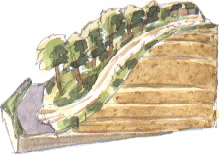
Erosion GullyMonday 28th August 2000, West Yorkshire
Haresfoot Clover Haresfoot Clover grows on the grassy trackside at the top of Millbank. It looks like a pinkish grass or plantain that has gone to seed, so it would be easy to overlook (unless, like me, you take an interest in grasses and plantains!). Although I don't remember having seen this plant before, the name Haresfoot Clover comes into my mind as I look at its furry flowers and its elongated version of the three-lobed clover leaf.
Haresfoot Clover grows on the grassy trackside at the top of Millbank. It looks like a pinkish grass or plantain that has gone to seed, so it would be easy to overlook (unless, like me, you take an interest in grasses and plantains!). Although I don't remember having seen this plant before, the name Haresfoot Clover comes into my mind as I look at its furry flowers and its elongated version of the three-lobed clover leaf.Later I realise why it is so familiar; I painted this species, also known as Rabbit's-foot Clover, Trifolium arvense about ten years ago for Wild Flowers of North America, published by Gallery Books, New York, and Dragon's World, London in 1990. It was written by Pamela Forey who, as I found out to my cost, was a terribly keen botanist. She wanted all the diagnostic details included in the illustrations. She'd have sent Monet's water lilies right back to him, saying he hadn't shown all the stamens. The discipline of drawing several hundred botanical studies to Pamela's exacting requirements has meant that, to this day, I still look out for bracts, tendrils, stem grooves and plant hairs when I look at a wild flower, so I owe her a debt of gratitude, much as I might have grumbled at the time. My clovers are on page 80/81 of the book, and I'm still pleased with them. Of course, if I did them again, and I didn't have a botanist to please, I'd do them differently, but for the brief I was given, they're not too bad. The artwork also appears in a European volume. And, by the way, Dragon's World were good enough to return the artwork, so if you're ever looking for a hundred small botanical studies to frame for your wall, please send me an e-mail. You know a set of three would look great over there in the corner by your computer . . . I'm afraid some of the clovers and orchids have already been sold. You're welcome to take a look at my Willow Island Gallery to see a small selection.  Haresfoot Clover is typical of grassy places and waste ground, and is often found alongside Sheep's Sorrel, Shepherds' Cress and Birdsfoot.
Haresfoot Clover is typical of grassy places and waste ground, and is often found alongside Sheep's Sorrel, Shepherds' Cress and Birdsfoot.Related LinksGeology can stretch from the pebble that you pick up in your hand to a satellite image. It can reach back in time from yesterday's storm to a dinosaur's footprints. So, after looking at a local gully, here's the bigger picture; the United States Geological Survey.And, on this side of the Atlantic check out the Earthwise publications (some of which I've written and illustrated), maps and regional guides published by our own British Geological Survey.
|




 THE HEAVY RAIN turned Deadman's Lane, Thornhill, into an erosion gully. A walk up the rough track is like following a (dried up) river to from its mouth to its source. Here, on the path beneath your feet, are erosion and deposition features that you'd find associated with a full scale river.
THE HEAVY RAIN turned Deadman's Lane, Thornhill, into an erosion gully. A walk up the rough track is like following a (dried up) river to from its mouth to its source. Here, on the path beneath your feet, are erosion and deposition features that you'd find associated with a full scale river.